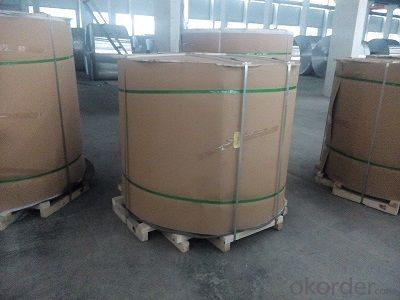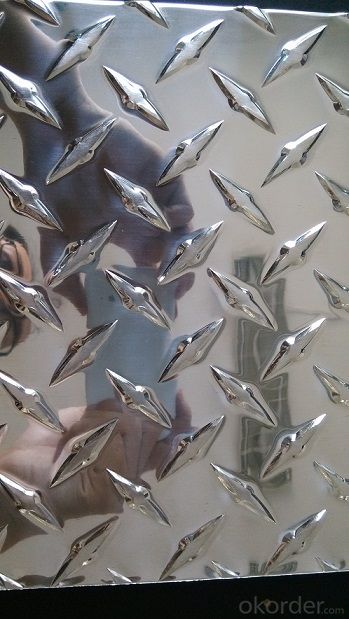Pattern aluminum coil
- Loading Port:
- China Main Port
- Payment Terms:
- TT OR LC
- Min Order Qty:
- -
- Supply Capability:
- -
OKorder Service Pledge
OKorder Financial Service
You Might Also Like
Pointer type pattern roll.Aluminum hard alloy checkered plate: 3003 as the main raw materials, strength slightly higher than ordinary aluminumalloy pattern plate, has a certain anti rust performance.Mainly used for non slip floor and building decoration etc.I produced the thickness range from 1.143mm to 3.175mm, width range from 900mm to 1500mm. The pattern of reinforced high according to the thickness of the aluminum plate was increased from 0.6mm to 1.2mm .3003 alloy. Smooth and bright surface, the pattern for a bar, also known as pointer type. Mainly for export. For export packagingvertical packing seaworthy,Plate thickness 1.143mm, corresponding to the pattern height 0.6mm, plate thickness 1.422mm, corresponding to the pattern height 0.65mm, plate thickness of 1.473 corresponding pattern, height 0.7mm; aluminum thickness 1.60mm,corresponding to the pattern height 0.80mm, plate thickness of 2.0mm, the corresponding pattern height 0.90mm;aluminum thickness 2.54mm, the corresponding pattern height 1.0mm; aluminum thickness 3.0mm


- Q:Are aluminum coils easy to install?
- Yes, aluminum coils are generally easy to install. They are lightweight and flexible, making them convenient to handle and position during installation. Additionally, they can be easily cut and shaped to fit the desired space, making the installation process relatively straightforward for experienced professionals or DIY enthusiasts.
- Q:Can aluminum coils be used for food storage and processing?
- Food storage and processing can indeed utilize aluminum coils. The multitude of advantageous properties that aluminum possesses is what makes it a popular choice in this field. Its lightweight nature, strength, and resistance to corrosion create an ideal environment for maintaining the quality and freshness of food. Aluminum coils are versatile and can be used to manufacture a wide range of equipment like containers, pans, trays, and foil for food storage and processing. Additionally, the excellent thermal conductivity of aluminum enables efficient cooling and heating of food. Its impermeability to light, moisture, and oxygen is also beneficial in preventing spoilage and contamination. In conclusion, aluminum coils offer a reliable and secure option for food storage and processing needs.
- Q:Who knows about how much money can be sold in a three metre high similar aluminum door?
- How wide is it, mainly to see the door you have multiple components, scrap is generally about 10 yuan a kilogram!
- Q:How are aluminum coils protected against oxidation during storage?
- Aluminum coils are protected against oxidation during storage by applying a thin layer of protective coating or by storing them in a controlled environment, such as a dry and moisture-free area. This prevents exposure to oxygen and moisture, which are the main factors contributing to oxidation.
- Q:What are the common fabrication techniques used for aluminum coils?
- The common fabrication techniques used for aluminum coils include rolling, annealing, slitting, and coating. Rolling is a primary fabrication technique that involves passing the aluminum through a series of rollers to reduce its thickness and achieve the desired shape. This process can be done using either hot rolling or cold rolling, depending on the specific requirements of the application. Hot rolling involves heating the aluminum to high temperatures, making it more malleable and easier to shape, while cold rolling is performed at room temperature. Annealing is another important technique used for aluminum coil fabrication. This process involves heating the aluminum to a specific temperature and then slowly cooling it down to enhance its mechanical properties. Annealing helps to relieve internal stresses, improve the aluminum's formability, and enhance its overall strength. Slitting is a technique used to cut wide aluminum coils into narrower strips. This process is typically performed using specialized machines that can slit the coils to the desired width. Slitting allows for more precise customization and can be used to produce coils of different widths to meet specific requirements. Coating is a common fabrication technique used to enhance the durability, corrosion resistance, and appearance of aluminum coils. Various coating methods, such as painting, anodizing, or powder coating, can be employed to provide a protective layer on the surface of the aluminum. This helps to prevent oxidation, improve weather resistance, and enhance aesthetic appeal. These fabrication techniques are commonly used in the aluminum industry to produce high-quality coils that can be further processed and utilized in various applications, including construction, automotive, aerospace, and electrical industries, among others.
- Q:Can aluminum coils be used for heat transfer applications?
- Yes, aluminum coils can be used for heat transfer applications. Aluminum is known for its excellent thermal conductivity, which means it is highly effective in transferring heat. Aluminum coils are commonly used in various heat transfer applications such as air conditioning systems, refrigeration units, and heat exchangers. The lightweight and corrosion-resistant properties of aluminum also make it a popular choice for these applications. Additionally, aluminum coils can be easily shaped and formed, allowing for efficient heat transfer in complex systems.
- Q:What are the different pre-treatment methods for aluminum coils?
- Some of the different pre-treatment methods for aluminum coils include cleaning, degreasing, etching, and phosphating. Cleaning removes dirt, dust, and other impurities from the surface of the coil. Degreasing eliminates oils and greases that may be present. Etching creates a rough surface on the aluminum, which helps in improving adhesion for subsequent coatings. Phosphating involves applying a phosphate coating to enhance corrosion resistance and improve paint adhesion. These pre-treatment methods ensure that the aluminum coils are properly prepared before any further processing or coating.
- Q:Does anyone know of any men's deodorant that doesn't contain aluminum? It has to be strong, as I do sweat a lot.
- Deodorants Without Aluminum For Men
- Q:Can aluminum coils be anodized in different colors?
- Aluminum coils possess the capability to undergo anodization in diverse shades. Anodization, an electrochemical procedure, forms a protective oxide coating on the aluminum surface while also enabling the introduction of various hues to the metal. By skillfully managing process factors like electrolyte type and concentration, voltage, and anodization duration, one can attain an array of colors. The color variation primarily arises from the interference and reflection of light stemming from the porous oxide layer created during anodization. Consequently, aluminum coils can be anodized in a broad spectrum of colors, encompassing shades such as black, bronze, gold, blue, red, and green, among others. The ability to anodize aluminum in diverse colors renders it an adaptable material suitable for an assortment of applications, including architectural, automotive, and decorative purposes.
- Q:Are aluminum coils suitable for manufacturing cookware?
- Aluminum coils, indeed, prove to be appropriate for the production of cookware. The reason behind aluminum's popularity in cookware lies in its exceptional heat conductivity, which results in uniform heating and efficient cooking. Moreover, its lightweight and sturdy nature make it convenient to handle and long-lasting. Additionally, aluminum possesses resistance against rust and corrosion, making it the perfect choice for cookware frequently exposed to water and heat. Nevertheless, it is crucial to acknowledge that uncoated aluminum cookware might react with certain acidic or alkaline foods, leading to a metallic taste. To tackle this issue, numerous aluminum cookware manufacturers utilize non-stick coatings or anodized finishes to prevent food reactions and enhance the cookware's durability. All in all, aluminum coils serve as a suitable material for the manufacture of cookware, but it is imperative to consider the specific requirements and coatings necessary for various types of cookware to ensure safety and optimal performance.
1. Manufacturer Overview |
|
|---|---|
| Location | |
| Year Established | |
| Annual Output Value | |
| Main Markets | |
| Company Certifications | |
2. Manufacturer Certificates |
|
|---|---|
| a) Certification Name | |
| Range | |
| Reference | |
| Validity Period | |
3. Manufacturer Capability |
|
|---|---|
| a)Trade Capacity | |
| Nearest Port | |
| Export Percentage | |
| No.of Employees in Trade Department | |
| Language Spoken: | |
| b)Factory Information | |
| Factory Size: | |
| No. of Production Lines | |
| Contract Manufacturing | |
| Product Price Range | |
Send your message to us
Pattern aluminum coil
- Loading Port:
- China Main Port
- Payment Terms:
- TT OR LC
- Min Order Qty:
- -
- Supply Capability:
- -
OKorder Service Pledge
OKorder Financial Service
Similar products
New products
Hot products
Hot Searches
Related keywords






























